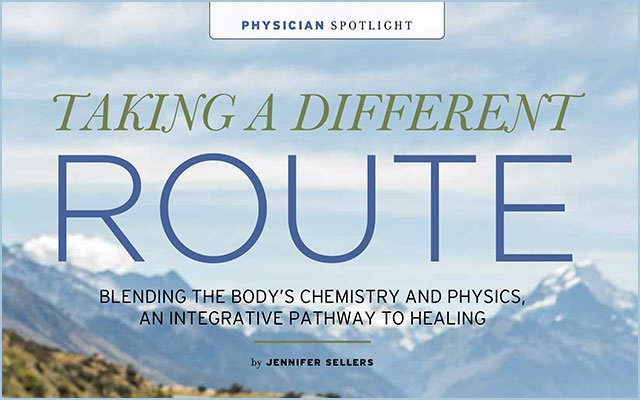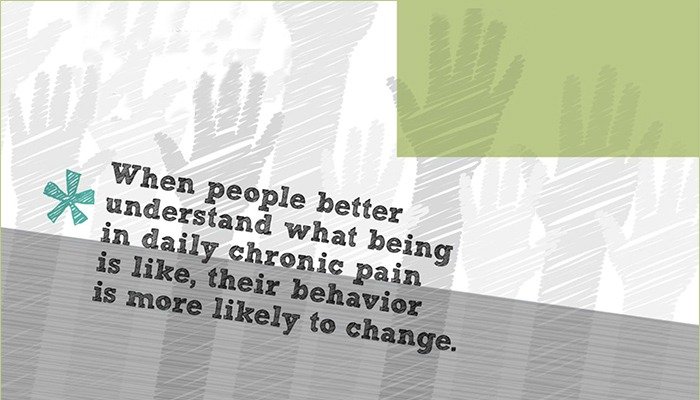Combining Conventional & Integrative Medicine

Imagine you’re trying to reach an important destination, and there’s only one way to get there—a crowded highway that sends you through miles upon miles of rough roads and traffic delays, with no exits in sight. If only you knew of an alternative route, you’d make an escape off the beaten path—even if there were fewer signposts and fellow travelers along the way.
Many who suffer from chronic pain can identify with such a scenario. They’ve been journeying a long time toward their destination of healing, and even though they’re traveling a well-worn path, they seem to make little progress along the bumpy and unpredictable way. These are people who feel stuck along the highway of conventional medicine. Fortunately for them, there is an off-ramp known as integrative medicine.
Integrative medicine is a field of medicine that combines conventional and complementary treatments in order to address the root causes of chronic illnesses. Integrative medicine takes a holistic approach to healing by evaluating all elements of a person’s well-being—physical, mental, relational and spiritual—and formulating a combination of personalized therapies that will address each patient’s unique case. This specialty is growing in popularity as more people take ownership of their health and seek to navigate beyond the route of traditional medicine.
The growing demand for integrative medicine, along with the passion and persistence of a handful of doctors, is what led to the establishment of the Integrative Medicine Center at Wake Forest Baptist Health in Winston-Salem, North Carolina.
WHEN THE PAIN DOCTOR BECAME THE PAIN PATIENT
Caryl J. Guth, MD, established a pain clinic in the San Francisco Bay area, where she practiced for nearly 35 years. For 25 of those years, she was in severe pain related to a whiplash injury she had sustained. After other pain-relief methods failed, Dr. Guth sought the advice of colleagues who told her to “learn to live with it.” During this time, Dr. Guth’s brother approached her about an alternative-energy product. Initially, she scoffed at the idea.
“I thought he was out of his mind,” she says. “Here I was a doctor, and he wasn’t. I knew there was no literature (that I was aware of) to back it up, so I wrote it off.”
Despite Dr. Guth’s reaction, her brother still sent her the device, so she decided to wear it—secretly. “I tried it out, and lo and behold it helped—but I wouldn’t tell anybody; I would wear a turtleneck in the operating room so that I could hide it,” she says. “But as I wore it, I realized something was changing. It was drawing out the lactic acids and toxins from the injury, and after about a year, I didn’t have to wear it any longer. I had become a patient in my own pain clinic, and a successful one at that.”
This was in the mid-’90s when integrative medicine was just starting to find its feet. Many medical professionals were still very skeptical about complementary practices. When a colleague in Dr. Guth’s clinic asked her to produce research to support her personal experience, she couldn’t. She had already sought the research on her own and had only come across non-English-language studies. Her colleague then suggested she conduct her own double-blind studies.
“I thought, ‘What an absurd remark—as if I have a research apparatus, assistants, time and money on my hands,’” remembers Dr. Guth.
However, Dr. Guth was nearing the start of her retirement, so she decided to make integrative research a new mission. She didn’t feel that nearby Stanford University and UC–San Francisco would warm to the idea, but she suspected she might have clout at her alma mater back East—Wake Forest University (WFU).
When Dr. Guth arrived at WFU in 2001, she had three objectives: 1) conduct research in the area of integrative medicine, 2) introduce integrative medicine topics into the medical school curriculum, and 3) establish an integrative medical clinic. While the first two goals have been slow going, Dr. Guth has seen the fulfillment of goal No. 3. In May 2017, the Integrative Medicine Clinic at Wake Forest Baptist Health was opened.
A PHYSICIAN’S AWAKENING
Dr. Guth wasn’t the only physician to change her point of view about medicine mid-career. Russ Greenfield, MD, was an emergency medicine doctor with the Carolinas Healthcare System in Charlotte, North Carolina when a series of events caused a shift in his thinking. Now he’s the medical director of the Integrative Medicine Clinic at Wake Forest Baptist Health.
Dr. Greenfield first became aware of what he calls “the dysfunction of traditional medicine” when he worked in the emergency department.
“Even though I was pretty happy in emergency medicine, I looked around and saw that most everyone else was unhappy,” says Dr. Greenfield. “It’s obvious that patients in an emergency setting aren’t going to be happy, but I noticed that no one else was either. There were unhappy doctors and nurses, unhappy staff and administrators, unhappy insurance and pharmaceutical people. Everyone was just unhappy and plugging along. I started thinking that maybe people are inherently unhappy in a system where all they do is put band-aids on problems. I saw that traditional medicine is very good at treating immediate physical maladies, but not so good at preventing them in the first place.
One day during this period, Dr. Greenfield was browsing through an airport magazine stand while he waited for a delayed flight. there, he picked up something that would eventually change the trajectory of his career.
“I was giving a lecture for an emergency medicine meeting, and my plane was delayed,” Dr. Greenfield remembers. “I was looking through magazines, and one had a cover picture of a guy covered in mud and holding a plant. The cover line was: ‘Can this man change medicine?’ It was a profile on Dr. Andrew Weil.
“Never before or since have I picked up that magazine in an airport, but I bought that one and read it once I got back home,” Dr. Greenfield continues. “About a third of the way through, the article mentioned that Dr. Weil and his peers were starting a new fellowship program at the University of Arizona, with the stated purpose of righting the ship of health care.”
Dr. Greenfield talked it over with his wife, and they decided to move to Arizona for the two-year fellowship.
On the second day of the program, Dr. Greenfield attended a lecture that prompted a radical shift in his thinking about medicine. “This professor of virology was speaking to us about the science behind paradigm shifts, and was covering the three forms of knowledge: belief, opinion and fact,” he says. “He asked us to consider the things we know as fact, such as, ‘HIV causes AIDS.’ But then he asked, ‘If HIV causes AIDS, why do many people who are HIV positive never develop AIDS?’ Then he asked us, ‘What if the facts that everyone thinks are facts aren’t really facts? What if, for example, a protein causes AIDS but is only activated in the presence of the HIV virus? What if we need to look more closely at what’s going on in the body instead of relying on easy assumptions?’ That hypothesis blew my mind. From the get-go, we were asked to consider the human body anew. That changed everything for me.”
A NEW PHILOSOPHY OF HEALTH CARE
Dr. Greenfield says he completed the fellowship with a completely new philosophy on health care, one in which a focus on whole health comes alongside appropriate and trusted disease management, all while tapping into the body’s innate healing capacity.
“I went from a linear dogma of conventional disease treatment toward an idea that each person has unique healing possibilities,” says Dr. Greenfield. “I started believing that the role of a health care provider is to facilitate optimal functioning possibilities within his or her patients. And with my background in traditional medicine, I started to see that a cogent combination of conventional and complementary care could achieve that.”
Dr. Greenfield says that his unique medical experience makes him feel like “the most fortunate of providers”: “Thanks to my emergency medicine background, I know what to do to help people in dire emergency; and thanks to my integrative medicine training, I know how to help people avoid (in many cases) getting to that point in the first place.”
Take a look at this video about the Integrative Medicine Clinic at Wake Forest Baptist Health.
According to Dr. Guth, that kind of balanced approach is needed. “Medicine today greatly helps the acute problem, but not the chronic problem,” she says.
Dr. Guth says she believes, in particular, that conventional medicine focuses much more heavily on chemistry than physics. “If the focus is only on chemistry, the body becomes toxic,” she says. “We need to bring chemistry and physics together so that it’s not just what we’re putting in the body but what we’re doing with the body. So often, when we only address the chemical, it just perpetuates chronic problems.”
Dr. Greenfield uses the example of chronic pain to suggest that an integrative approach with complementary therapies can help disrupt the status quo of traditional treatments.
“There are many different sources of pain, and we often feel like we need external help to get control of it,” he says. “Sometimes we do, but then sometimes there are things we can do on our own, which an integrative physician can help facilitate. Take nutrition, for example. We’ve known that nutrition can be used to prevent certain inflammatory disorders, but now we believe nutrition can also be used to ameliorate pain to a certain degree. That’s just one area to look at. We can also look at other therapies, such as mind-body treatment, that may have an impact on a patient’s pain, while also giving them a sense of control over their own health.”
In additio, Dr. Greenfield says integrative physicians can help patients navigate the therapies available so that they can focus in on what might work best for them. He says the sheer number of therapies and combinations of therapies available could create a potential minefield for the average patient.
“We want tohelpp them find a map that works for them,” he says. “And we want to apply science to complementary therapies, never accepting or recommending them uncritically.”
PARTNERS, NOT ENEMIES
Dr. Greenfield is also quick to point out that integrative medicine is not intended to be a replacement for or alternative to conventional medicine. Rather, he says, it’s meant to work in harmony with it.
“We’re never going to say, ‘Don’t take these critical medicines, or stop that important treatment,’” he says. “Instead, we’re going to frame the conversation in a way that helps us find the most prudent balance of conventional and complementary therapies. And, we’re there to offer help when it can’t be found elsewhere. There isn’t always necessarily a prescription that will solve something like chronic fatigue syndrome, for example, but there’s still much we can do to help those patients.”
Dr. Greenfield says he hopes integrative physicians will be seen as trusted partners of the specialists and primary care providers in traditional medicine. He says one way they can do that is by being up to date on the supportive data behind complementary therapies. “With all the new information that is constantly coming before them, it can be a struggle for them to stay up to date in their own fields,” he says. “So it can be hard for them to also know what’s going on in the integrative fields.
“We want them to know we’re helping them help their patients,” Dr. Greenfield continues. “They’re not going to lose their patient or have their patient sent down a crazy pathway that doesn’t serve them well or impairs their health. We never want patients to get mixed messages—whether we are their sole provider or just a complement to another provider. We want to be that bridge for patients and physicians alike.
“Relationships have always been a foundation of integrative medicine,” says Dr. Greenfield. “Working together with patients and with other providers will help us achieve our ultimate goal, which is to unlock greater healing, greater comfort and greater health for each individual patient.”
PainPathways Magazine
PainPathways is the first, only and ultimate pain magazine. First published in spring 2008, PainPathways is the culmination of the vision of Richard L. Rauck, MD, to provide a shared resource for people living with and caring for others in pain. This quarterly resource not only provides in-depth information on current treatments, therapies and research studies but also connects people who live with pain, both personally and professionally.
View All By PainPathways






